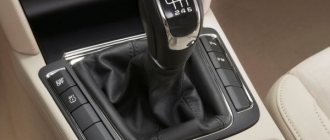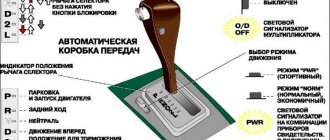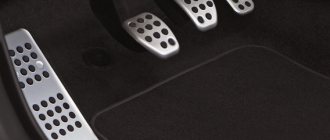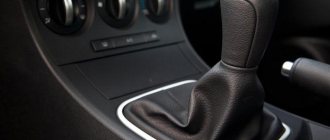Hi all! Many people want to get behind the wheel of a car and enjoy the benefits of a personal car. But before you do this, you have to go through a difficult learning curve. Practice clearly shows that the main problems arise with how to change gears correctly and with mechanics.
Initially, the most difficult thing for a beginner seems to be simply learning how to get going. But in just a few practical sessions this point can be mastered until it becomes automatic.
But switching to a manual transmission while driving is more difficult. This is a gradual process of developing a reflex that allows you to move from one speed to another in a timely manner and without being distracted by the lever itself, almost at the level of intuition.
The key rule is to always use the clutch pedal. In theory, you can learn to shift without a clutch, but then the box won’t last long and will have to be replaced soon. Therefore, when braking and accelerating, the clutch pedal and gearshift lever must work in tandem.
Important nuances
Ideally, the car should drive without jerking, moving from one speed to another. When buying a used car or a new car, all buyers always look at such a detail as the type of gearbox used. Objectively, the easiest car to drive is considered to be an automatic transmission. But it is important to understand that there are a number of types of gearboxes, and not a simple division into manual and automatic. We recently studied with you the features of sequential gearboxes, and also got to know the variator in more detail. I advise you to re-read and update your own knowledge regarding automobile gearboxes. In terms of reliability and durability, classical mechanics still firmly holds the first position.
When used correctly, the car can accelerate quite quickly, squeezing the maximum out of the installed engine. But when the engine is powerful, and the driver does not know how to shift correctly, then no amount of horsepower will help you.
One general principle applies to all manual transmissions. It consists in the fact that first the clutch is depressed, then the speed is switched, after which the clutch pedal is lowered.
Starting the engine at low temperatures
In winter, a car (especially if it has hundreds of kilometers behind it) freezes, just like people, so it is more difficult to start the engine. To help it “warm up,” it is recommended to close the engine shutter and not start the starter for more than 10 seconds, taking a break of at least a couple of minutes between attempts. During this time, the battery will have time to return to normal.
If after 3-4 attempts you cannot start the engine, you need to figure out the reason.
If the engine starts, you need to wait a while, monitoring its operation, i.e. the desired crankshaft speed. Otherwise, the car may stall again.
This is done using the gas pedal and throttle. The engine can stall if the throttle is too open or not enough, so the driver’s task is to learn how to correct it by listening to the engine.
When to switch
Switching should be smooth, but at the same time fast.
Many are rightly interested in when exactly it is necessary to switch from one speed to another. Although there are different cars and boxes, there are averages. Namely:
- The first speed is intended mainly for starting, and is not used for active driving. The current speed here is from 0 to 20 kilometers per hour;
- The second speed is accelerating and is used for movement at low speed in the range from 20 to 40 kilometers;
- The driver must switch to third when he needs to accelerate from 40 to 60 kilometers per hour;
- The fourth is suitable for speeds from 60 to 80 kilometers per hour;
- Fifth and sixth speed for driving over 80 kilometers per hour.
These numbers are approximate and average, as there are a number of other factors that affect driving.
The presented diagram is relevant for cars that are not loaded and move along the road without resistance in the form of sand, deep snow or steep inclines. If there is such resistance, then it is recommended to switch to the next gear a little later.
Motorists and driving instructors have developed a useful reminder that they recommend that a beginner remember. The bottom line is this:
- It is always recommended to use first gear solely for starting;
- After the start, you should immediately turn on second speed;
- Second gear serves as acceleration speed on a manual transmission;
- The third is optimal when overtaking;
- The fourth performs best when driving in urban conditions;
- The fifth and sixth are used for expressways, highways and highways.
You can also shift out of order if necessary, shifting from high to low to apply engine braking.
There are a number of visual videos on the Internet about how to properly operate the gearshift lever on a manual car. Both high and low gears are discussed in detail.
Secrets of efficiency
The most economical fuel consumption occurs when the engine operates from two and a half to three thousand rpm.
Some drivers disagree with this point of view. They believe that fuel consumption decreases at a thousand to one and a half thousand revolutions per minute when maintaining the speed and quickly moving to higher gear levels. This opinion is incorrect - the car will need much more fuel to accelerate, and the driver will react to changes in the situation much slower than at a speed of about three thousand.
ADVICE! To determine how to correctly shift gears on a manual transmission, it is important to know what layout is used in the latest models of cars with a manual transmission. Most often, gears from fifth to seventh are designed specifically to save fuel.
Maximum speed can be achieved in fourth gear or fifth. If you upshift too early, the revs will drop and fuel consumption will increase. In addition, the last steps were created for driving on country highways, and not on city streets.
Switching process
When driving straight and during a turn, the driver needs to change the current speed set on the mechanics.
This is done according to a certain algorithm, which can be represented as follows:
- With a tight movement, the clutch pedal is pressed to the floor with the left foot;
- At the same time, you must release your foot from the gas pedal;
- smoothly but quickly select the desired gear on the box;
- when passing the lever, you first return to neutral, and then to the required speed;
- then the clutch is released;
- at the same time, work begins with the gas pedal so as not to lose speed and revolutions;
- After the clutch is fully released, good gas is added.
There are no strict and rigid restrictions in terms of the sequence of transitions at speed. Nobody forces you to shift in a strictly specified order, from 1st to the last gear.
But if you skip speeds, then you will have to spend more time accelerating and the speed will begin to drop.
Switching speeds on “mechanics”
The gearbox is designed to generate an additional ratio of rotational speed to the wheels of the car from the engine. The gearbox stages (gear ratios) must be switched manually by the driver using the selector. Thanks to mechanization, which requires human participation, this type of gearbox is called “mechanical”.
The manual transmission works together with the clutch, a mechanism that transmits torque to the wheels requiring the vehicle to move, allowing you to soften the process of gear shifting without turning off the speed of the internal combustion engine. Otherwise, the torque required to move the car may tear the box to pieces.
The ability to control the clutch is made possible by a pedal located below, under the driver’s feet, in close proximity to the brake and accelerator. The basic rule for long-term operation is to change gears on your favorite mechanics only when the clutch pedal is pressed all the way.
IMPORTANT! The gearbox of used imported cars may have a non-standard inclusion scheme.
How to choose a tow bar?
The mistake of beginners is usually standard, and it lies in the inconsistent action of the manual lever and the clutch pedal. As a result, the car loses speed and sometimes stalls.
Motorists who have only recently gotten behind the wheel are often easily identified not only by the U icon on the glass, but also by absent-minded and abrupt switching.
When the car starts moving, inexperienced drivers regularly release the clutch early. As a result, the car jerks, and the transmission itself gradually fails.
Considering the speed ranges relevant for shifting gears, many believe that when the car is not traveling more than 40 km/h, there is no need to switch from 2nd to 3rd gear. But remember that a higher gear does not necessarily require an increase in speed. You can safely push the third, but at the same time drive the 40 kilometers set by the limit sign.
A higher gear only allows you to go faster. That is, when choosing speed 3, it will be easier for you to accelerate from 40 to 80-100 kilometers per hour, it will take less time and the engine will behave better than when accelerating from speed 2. Having the ability to speed up does not obligate you to speed up.
Do you want the car to buck? Turn it down!
With downshifts the situation is somewhat more complicated than with upshifts. If you are a novice driver and this is not obvious to you, do the following: accelerate to 50 km/h in 3rd gear, engage 2nd gear and quickly release the clutch pedal as usual. As a result, the tachometer needle will jump up sharply, and the car will jerk violently. Try it! Happened?
This will always happen when moving from a higher gear to a lower gear, only the intensity of the jerk will be different depending on the speed and gear. Why does the jerk occur? As the sharply “bouncing” tachometer needle shows us, when the gear is lowered, the engine speed increases. If, when switching from II to III gear, the needle drops from 3500 to 2500 rpm, then when switching from III to II, on the contrary, it jumps from 2500 to 3500. This means that by including a lower gear, we forcibly accelerate the engine to higher revs. Since the rotating parts of the engine are heavy and inert, they resist spinning up, which is what results in the machine jerking . It turns out that the jerk is like a protest of the motor










